Fusilier Battalion (Major Rider) - 275. Infanterie Division
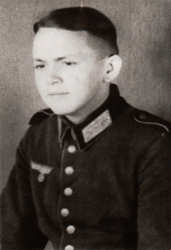
The following is my experience of the deployment in the Düren area:
May 1943: — Paramilitary camp Mariawald near Heimbach/Eifel.
Sept.1943 - April 1944: — RAD (?) camp in Wassenberg/Myhl.
May 1944 - August 10, 1944: — Assigned to 14th Company/Rifleman in tank unit of 275. Infanterie Division in the Lützow barracks in Aachen. Transfer to the Riemann barracks in Düren. That happened by foot march via Stolberg and Langerwehe. In Düren more and more vehicles columns passes through from France, mostly Luftwaffe.
Sunday, September 3, 1944: — Alarm, to the front.
Monday, September 4, 1944: — Assigned with Cadet Werner Böttcher to stop enemy tanks with Battalion 464 in Eschweiler.
Werner Böttcher talked to his father in the barracks in Eschweiler and asked for my home address in case we lost touch.
We marched on foot with a group of maybe 20 men toward Maastricht, crossing the border in Herzogenrath - Kerkrade. West of Maastricht we took up our position at the Albert Canal. There we experienced the first American artillery assault. We had already experienced the mighty allied air forces in two bigger air raids at the Aachen Rothe Erde train station in late May 1944.
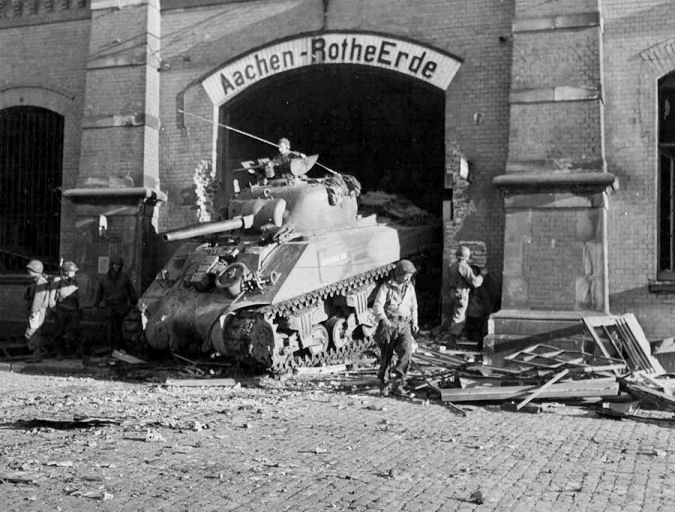
A Sherman tank makes its way through the main entrance of the train station of Aachen - Rothe Erde. October 1944.
Saturday, September 16, 1944: — In the early afternoon advancing American tank troops broke up our unit near Bunde on the road from Maastricht to Sittard and I was assigned to Major Riedel's battalion. I never saw Werner Böttcher again. He fell there on 09/18/44 as his parents wrote to my parents in 1946. This letter as well as the first one sent to my parents on 12/04/44 show the sorrows and pain of people, especially people in a war zone.
Tuesday, September 19, 1944: — American tanks, advancing from Waubach, drive us out of Scherpenseel. The bypass us to the right and set a few farms in Teveren on fire. They stop at the end of the village on the road to Geilenkirchen. We take up position at the southwestern edge of Geilenkirchen.
Friday, September 22, 1944: — Our unit is taken out of the battle and we go to Gereonsweiler to rest. But as soon as we had fallen asleep in a farmhouse, under clovers of wheat, a new order arrives.
Saturday, September 23,1944: — Early in the morning we reach Derichsweiler. Line up, review of the situation, and conferring an order by the commander, are followed by immediate deployment to the hill near Schevenhütte. Our battalion set up positions to the left, i.e. south of the road from Gürzenich to Schevenhütte. The town itself was occupied by the Americans as was the outdoor swimming pool south to it.

Former outdoor swimming pool at Schevenhütte.
Closed in 1977.
Our battalion's and regimental command post was to trigonometric point 312. The medical orderlies were also in that neighborhood. We destroyed the observation tower that stood high above point 312 because it could have made an excellent directional target for the enemy artillery. Since I was company runner I had to run in between combat post Schwarzenbroich in the middle of the forest and another combat post, Hardt Farm, quite often. I remember well that a dam had been built across the forest aisle. That dam led south of Schwarzenbroich, near Point 312 into the main road.
Compared to what I have experienced between October 7 and November 28, 1944 southwest of Hürtgen, we had a rather quiet front-line here at Schevenhütte. Sure, there was artillery fire, but it remained palatable. Besides reconnaissance operations and unsuccessful minor assault troop missions we spent our time improving the dugouts.
Increasing combat could be heard, however, in the neighboring sector to the right, toward the Wenau forester's district. At night artillery shells flew above our heads to Düren.
Our enemy at that time near Schevenhütte was the 47th Regiment of 9th US Infantry Division. That regiment had been part of the 3rd US Armored Division that had advanced to Schevenhütte in the Zweifall-Stolberg area.
It is of interest for me today that the 3rd US Armored Division led the southern pincer at the end of March 1945. Here in my home area they met the troops that advanced north of the Ruhr Valley and encircled the Valley on 04/01/45. General Rose, commander of 3rd US Armored Division died here, south of Paderborn , on March 30, 1945.
I remember how a company of our unit was deployed to the Eschweiler- Aachen area in late September/early October 1944.
On Tuesday, October 3, 1944 I wrote to my parents that I was billeted for a few days of rest in the house of farmer Heinrich Schmitz, Schlageterstraße 92, Gürzenich. It is the same house number today but the name of the street has been changed. Even the small bedroom window to the street on the upper level of the house, at the side facing Schevenhütte is still there.
At dawn of the 7th October 1944 we advanced along the winding road into the valley of the Weisser Wehe to counterattack the Americans who had broken through on the day before. Our 2nd Company attacked behind the bridge by point 312 in a southerly direction on the west side of the valley.
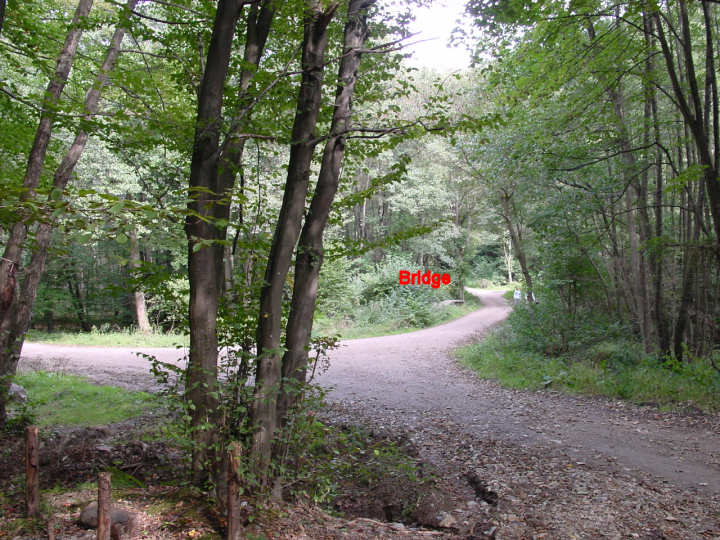
Point 312 in the Weisser Wehe valley.
After we had advanced some 1000 meters we came under American mortar and artillery fire as we reached a brook. The sad balance of the first day: 35 casualties, dead and wounded; more than one third of our battle strength of 100 soldiers. Among the wounded, my Company Commander Lt. Tatzel; among the dead, my First Sergeant Zeppenfeld. Lt. Lengfeld took over our 2nd Company.
On 18/19 October we were shifted to the east side of the Wehe brook. The other two companies of the battalion linked up closing the line from Germetsbach up toward the saw mill at Wittscheidt. We had to dig in, because most of our casualties came from tree bursts of artillery. With great effort we dug our foxholes with our primitive children’s spades, layer by layer in the slate stone. At midday an artillery salvo hit us. A medical aid man was killed by a fist-sized piece of shrapnel that hit him in the back. One asked sarcastically weither this was “the most beautiful death on the battlefield” which we had been taught to sing in the patriotic songs? However, not everyone who was hit had the good fortune to die so quickly and painlessly. At twilight another artillery salvo hit us, during which a splinter cut through a foot of our stretcher bearer.
During the late evening a piece of shrapnel tore the lower thigh bone off a comrade who was lying next to me in the foxhole. He died the next morning of an embolism. A NCO did not return from the reconnaissance squad: shot in the stomach. Hardly a day without casualties...

Over the front line area in the direction of Todtenbruch (Deadman's Moor) an American reconnaissance aircraft was constantly circling. We called them "Krane" (crows). The crew directed artillery fire on everything they saw on the roads or tree lanes. Our horse drawn supply wagon was completely destroyed.
With leaflets and loudspeakers the Americans called upon us to surrender. Surrender? No, had we not sworn our fidelity to the Fatherland? However, the next morning the foxholes of some 20 replacements, who had shortly before been attached to our company, were found empty. These were soldiers of "Volksliste 3", more Polish than German.
At the end of October there was another change of position: From the right wing in the valley to the left wing of the Fusilier Battalion, bounding here at the main road to the edge of the forest before the Wittscheidt saw mill, which along with the main road Gemeter-Richelskaul-Raffelsbrand-PeterBerg were in American hands after heavy fighting since mid-October.
On the morning of November 2nd (All Souls Day) a terrific artillery barrage fell on our positions (12,000 shells according to American literature). The earth and the air trembled an hour long. The 109th Infantry Regiment of the U.S. 28th Infantry Division took Katzenhardt Hill to the north. We lost our 3rd Platoon. Our telephone and radio circuits were out of commission, so the artillery observer and I were ordered to report the breakthrough and situation to Battalion as quickly as possible.
We hurried along the telephone cable which had been torn to shreds, and stood, barely 500 meters from here, at the tree lane, which runs from here to the forest point, suddenly confronting an advancing group of Americans who were hardly 20 paces away with rifles ready to shoot.
In those terrifying seconds before the GI's had yanked their rifles up to shoot, the two of us had jumped back into the forest again. We ran for our lives. The NCO screamed giddily: He had been hit by the furious rifle fire. Farther away as we approached our positions again we looked more closely at his very bloody elbow. A lucky shot which would allow the NCO to go home. I envied him.
In the early afternoon of 2 November, 1st Bn. of the 109th Infantry occupied the edge of the forest, southeast of Hürtgen, and captured the forester's lodge there. The next day they crossed the highway and took up positions in a small boxed shaped patch of woods.
On the afternoon of 2 November we immediately setup a line of defence, right up to the minefield "Wilde Sau", which had already been laid on the western side of road. A machine gun protected the mine-free lane, which today leads to the cemetery. We held this position until the 20th or 21st of November.
On 3 November our army leadership threw the 116th Panzer "Windhunde" Division into the torn up front between Schmidt and Hürtgen. On 4 November the grim counterattacks started. In the area between Vossenack and Schmidt heavy fighting raged, accompanied by artillery duels and tank battles. The U. S. Army Air Corps joined in the ground fighting, but thanks be to God because of the very bad weather the action lasted only a few days.
Here by Hürtgen counterattacks had already commenced on 3 November against the curved front of the 109th Infantry. On 7/8 November the 109th's sector of the front was taken over by the 12th Infantry Regiment of the 4th U. S. Infantry Division. I went with Lt. lengfeld on that day on a reconnaissance patrol up to the American outpost line, which thanks be to God, had not yet again been occupied.
At midday on 10 November a heavy artillery barrage lasting a half hour opened up on the point of the forest and on the American front line southwest of Hürtgen. This was a new attempt to throw the Americans back with all available means. After back and forth attacks lasting for days the forest point fell, and afterwards the forester's lodge at Hürtgen, which had changed possession several times; and on 13/14 November for some 10 days was again in German hands.
Here are a few sentences from the war diaries of units of the 116th Panzer Division:
10 November, midday; "Artillery Regiments 275 and 1020 and Armored Artillery Regiment 146, in a 25-minute preparation fire, laid the heaviest barrage on the area to be cleared...."
10 November, evening: "Southern Attack Group penetrated up to half way through the forest. Encountered stiff resistance, remained in position. Northern Attack Group has reached the forester's lodge in Hurtgen and then moved on to the north. In the sector there are three fresh battalions, parts of which are cut off in the forest and in heavy fighting with some infantry.
Expended: 1,676 empty cartridges.
Weather: Driving snow and rain."
11 November: "Heavy fighting in the area southwest of Hürtgen, have surrounded a small enemy group, but I am too weak to annihilate them. The exhaustion of the troops is very great, likewise the breakdowns. Very bad weather; for days the men are lying in wet clothes outside."
"During the night of 12 November, the Americans broke through the just formed HKL (main battle line) between trigonometry point 408.7 and the road knee southeast of Hürtgen, and reinforced their units which had broken through with two additional companies. The forester's lodge at Hürtgen was lost once again. At around 9 am the situation was again restored in a counterattack with the help of Tank Destroyer detachment 228...."
"The battles swung in continual bitterness back and forth. It is raining, wet snatches of fog or snow clouds sweep over the softened land beset with puddles. The fighting infantrymen wading, lying and fighting in mud are close to complete exhaustion. The reported battle strengths are sinking at an alarming rate. Continually the artillery battle rolls on."
"In the forest itself it looks completely crazy. The trees are leaning on one another through continual fire, and the roads are completely soaked, and everywhere stands water a foot high. The infantrymen look like pigs. No rest for over a week and not a dry thread on their bodies; for it is raining continually and fog is always at hand. It's a bush war: Man against man with enormous efforts for the individual man.... Infantry of the division is completely finished. There are only staffs there, and very few men: Even men who can't be brought forward at the point of a pistol, are also there."
"On 13 November the attack against the surrounded Americans in forest districts 91 and 92 commenced.... Most of the Americans escaped to their own lines. Only 27 prisoners were brought in. The forward line ran now from the west edge of forestry district 181 to the west bank of the (Weisser Wehe brook over point 408.7 to the northwest corner of the mine field "Wilde Sau".
On the evening of 13 November Field Marshall Model visited the staff of the 116th Panzer Division in a bunker near Grosshau... relief for the division was finally ordered, high time, since the division was heavily battered and exhausted."
On 10/11 November we went out of our positions south of the minefield "Wilde Sau" as a reconnaissance patrol in a westerly direction. After crossing the first firebreak we suddenly came upon an American reconnaissance patrol in low underbrush. I ducked instinctively when I heard the order "Hold" of a G.I. I didn't see the enemy. It was a case of "You or Me": Here in only a fraction of a second the patrol leader decided the question for himself, and with it also for the 3 of us left behind him. Hard to bare, these recollections, they stay with us for the rest of our lives.
Two of our machine gun crew, securing the mine free path, were shot through the head by American sharpshooters, who had infiltrated and were encircling us on the eastern side of the highway.
We had another enemy: vermin-lice! For weeks we had gone without washing and being able to change our undergarments in the damp foxholes. When I discovered a white band of lice eggs I threw the pullover immediately away, although I had a second urgent need because of the wet, cold weather. In my last letter from the front on 11 November I wrote of a severe cold, and "All the time we're experiencing here heavy fighting, although it appears that the situation will soon clear up...."
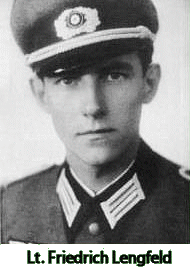
On 12 November, after the soldiers of the U.S. 12th Infantry Regiment had again captured the forestry lodge Hürtgen in a night attack, and during the morning lost it again. Our company received a heavy blow: During the early morning an obviously severely wounded American soldier was crying pitifully for help. He lay in the middle of the minefield "Wilde Sau" at the edge of the embankment on the eastern side of the highway, in No Man's Land. My company commander Lt. Lengfeld sent me with the order to the machine gun that was guarding the mine free path that in no case should it shoot if American medical aid men should come to rescue the severely wounded soldier. When the heart rending cries for help continued for hours Lt. Lengfeld ordered our medical aid men to form a rescue troop, it may have been about 10:30 am: Lt. Lengfeld went at the point of our rescue troop on our side of the street. The street itself was secured with antitank mines, whose location was relatively easy to recognize.
As Lt. Lengfeld was on the point of crossing the street directly over to where the severely wounded American was lying, an exploding anti-personnel mine threw him to the ground. In haste he was carried back to our company CP for first aid. Two deep holes in the back implied that there were severe internal injuries. Lt. Lengfeld groaned under deep pain. Under the leadership of a lightly wounded NCO he was carried immediately to the Medical Aid Station at Lukasmühle (Lukas Mill). But during the evening he died of his severe wounds at the main First Aid Station in Froitzheim. His last resting place is Grave No. 38 in Düren-Rälsdorf.
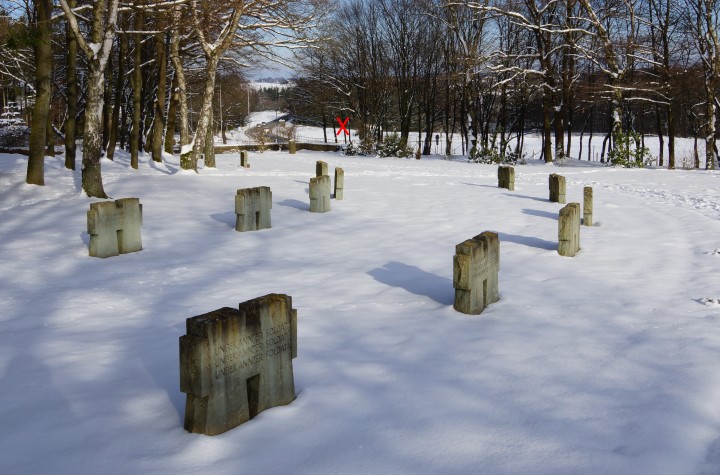
Cemetery at Hürtgen. The red cross marks the position of the wounded American soldier.
With this cruel turn of events, I lost my best commander. He had meant so much to me in the difficult weeks behind us, and he had given me much inner strength. He was an exemplary company commander, who never asked us to do more than he himself was ready to give. He was in the lead of our reconnaissance patrol as we moved up to the American outpost line. When American infantry ammunition exploded in the trees overhead and gave us the impression that the enemy had broken through, he did not order "Go at once!", but rather, "Come with me!"
Lt. Lengfeld was certainly one of the best soldiers of the Huertgen Forest. He possessed the complete confidence of his soldiers, and had great human qualities. This was proven by his conduct toward the seriously wounded enemy. From the company grade officers of his stature, essentially came the fighting strength of the troops. I was never able to determine the fate of the severely wounded American. He may have saved himself by reaching the American lines before this part of the forest fell into German hands on 13/14 November.
The forward push of the U.S. 8th Infantry Division on 20/21 November paved the way for the downfall of Hürtgen village. With the support of the U.S. Air Corps and the U.S. 5th Armored Division, after days of heavy fighting, they succeeded in pushing our troops out of the forest on both sides of the main road and they succeeded in taking the village of Hürtgen on 28 November 1944.
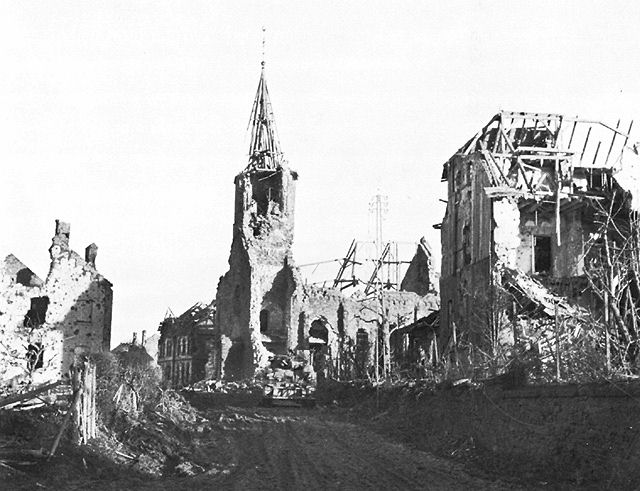
Tank attached to the 8th Div. moves through Hürtgen.
I was taken prisoner by the Americans, along with three of my comrades, in the cellar of the Forester’s House near the church. On the evening of 28 November 1944 either fate or Divine Providence allowed seven soldiers, all that remained of the 2nd Company, Füsilier Battalion, to go amongst other prisoners into the valley as prisoners of war. We had the good luck to survive.

Source: Memories of Hubert Gees, reposted by kind permission of Albert Trostorf / Merode.
